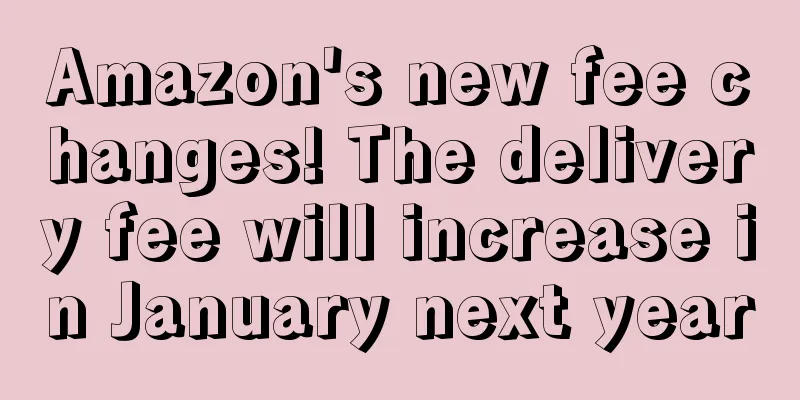Amazon's new fee changes! The delivery fee will increase in January next year

|
A few days ago, Amazon released the latest fee change announcement, stating that it will adopt the latest MCF delivery fee from January 19 next year. In this adjustment of MCF (Multi-Channel Fulfillment), sellers will be provided with upgraded delivery time services, with the standard delivery speed increased from 7 days to 5 days. After the official adjustment in January next year, Amazon will also provide three different delivery time options for sellers: 5-day delivery, 3-day delivery, and 2-day delivery, to meet the different time requirements of multi-channel sellers. However, this change cancels the ultra-lightweight pricing for products weighing less than 2 ounces , and products weighing less than 2 ounces will be merged into the same group of charging standards for products weighing 6 ounces or less. This also causes the cost of products of this size to increase the most. Taking standard parts as an example, the delivery fee for a single product weighing less than 2 ounces is currently $4.75; after the new policy is implemented in January 2023, the product will be merged into the 6oz fee, which is $7.15, an increase of $2.40, an increase of nearly 50% . Secondly, Amazon cancelled the charging standard for 5+ oz and changed it to start charging from 4. Taking the standard item as an example, the delivery fee for a single 6 oz order is now $5.35; after the new policy is implemented, it will be $7.15, an increase of $1.80, or about 33.6%. The above two billing stage changes are the largest part of the fee increase, and the other billing stage increases range from 10% to 20%. In short, the general increase in multi-channel delivery fees is quite exaggerated, almost two or three times the normal increase in FBA delivery fees in previous years. Although Amazon claims that the logistics and delivery fees it provides are lower than those of its competitors, the data I collected from the Internet shows that the latest price increase for USPS is an average of 5.5%, while UPS and FedEx will also have freight rate adjustments of around 6.9% next year . These adjustments are the latest changes that will take effect within a month. It can be seen that the increase is much lower than that of Amazon. Amazon’s repeated price increases have actually seriously affected the competitiveness of products on the platform. This year, it has used peak season surcharges, fuel and inflation surcharges, etc., to increase transportation costs again and again. Many third-party sellers have to raise prices to ensure profits. This year’s Black Friday Cyber Monday survey also showed that consumers are becoming more and more dissatisfied with the prices of online products, believing that the gap between online and offline products is no longer wide, and it is better to go to offline supermarkets with better after-sales and pre-sales experience. This is also one of the important factors that affected Amazon’s Black Friday Cyber Monday sales performance this year. The overall environment of Amazon next year will still be very severe. Everyone must make multiple preparations, look at other emerging blue ocean platforms, and plan and occupy positions in advance. |
<<: Amazon's sales have been cut in half! Will sales continue to shrink next year?
Recommend
What is Remote Fulfillment with FBA? Review of Remote Fulfillment with FBA
Amazon Logistics (FBA) has launched the Remote Ful...
What is Czech VAT registration? Czech VAT registration review
VAT is the abbreviation of Value Added Tax, which ...
Is it feasible or just wishful thinking to start an Amazon business with 10,000 yuan?
How much money does it cost to work alone on Amaz...
Is Amazon right for you?
Editor's Note In the near future, we will lau...
What is TrueOpinion? TrueOpinion Review
Trueopinion is a third -party review platform that...
What is the German Federal Central Tax Office (BZSt)? German Federal Central Tax Office (BZSt) Review
The Federal Central Tax Office (German: Bundeszent...
Specific steps to solve Amazon's misjudgment of restricted products
Whether you are a novice seller or an old seller,...
Have you noticed Amazon’s hidden advertising function?
text Many Amazon merchants frequently invest in a...
What is PhonePe? PhonePe Review
PhonePe is a mobile payment company that has devel...
What is eBizWare Inc.? eBizWare Inc. Review
eBizWare Inc. is a modern integrated warehousing a...
Amazon sellers must read these suggestions before purchasing shoes
Thanks to the growth of Amazon, it is now easier ...
What is CEC certification? CEC certification review
CEC is the abbreviation of California Energy Commi...
A large number of Walmart sellers are taking action, so be sure to pay attention to these words!
Have you ever had a product that was selling well ...









